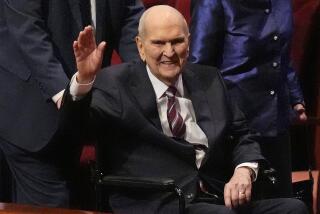Early Mormons Said to Endorse Women Priests
- Share via
SALT LAKE CITY — Women aren’t considered eligible for the priesthood by modern leaders of the Mormon Church, but a historian says the church’s founder thought otherwise.
D. Michael Quinn says founder Joseph Smith taught that women receive the faith’s priesthood as part of a sacred temple rite, but the doctrine is virtually unknown to the modern church and its male leadership.
“In effect, nearly all authoritative statements by (the church’s) modern apostles have been inaccurate concerning the matter of women holding the priesthood,” Quinn writes in a new book about the Church of Jesus Christ of Latter-day Saints.
Quinn, a Mormon, said there is compelling documentary evidence that Smith gave women priesthood power in the temple “endowment” ritual in which women are anointed to become queens and priestesses.
“It’s an explosive issue,” Quinn said, particularly at a time when church leaders face growing pressure from Mormon feminists for a more active role in a faith dominated by its male priesthood.
Mormons define priesthood as the literal power of God and as the authority to act in God’s name. They believe the “keys” to the priesthood came to Smith through heavenly intermediaries from Jesus Christ and have been passed on to the church’s 12 successive presidents.
Quinn said there is no evidence a woman ever was ordained to a specific priesthood office such as elder, high priest, bishop or apostle. But in the early church there was a clear distinction between priesthood power--available to women in the temple endowment--and priesthood office.
“The confusion of priesthood office with priesthood has characterized many contemporary discussions of women and priesthood,” Quinn wrote.
It wasn’t until the 20th Century that Mormon leaders completely backed away from the idea that women held the priesthood, Quinn said. In doing so, they relied on official histories that deleted evidence or changed meanings in “documents which were detailed and explicit in their original form.”
Still, for nearly 100 years after Smith’s death in 1844, Mormon women were authorized to perform the priesthood function of healing other women by anointing and blessing.
The issue is further complicated by the Mormon belief in continuing revelation from God to Mormon prophets. That principle was cited in 1978 when then-President Spencer W. Kimball lifted a ban against black males holding the priesthood.
Two weeks before Smith organized the Female Relief Society of Nauvoo, Ill., in 1842, he told the women that “the Society should move according to the ancient Priesthood” and he was “going to make this Society a kingdom of priests as in Enoch’s day--as in Paul’s day.”
Much later, in printing the official minutes of Smith’s remarks, the official “History of the Church” omitted Smith’s first use of the word “Society” and changed the second “Society” to “Church.”
“Those two alterations changed the entire meaning of his statement,” said Quinn, a former Brigham Young University historian who is writing a history of the church hierarchy.
Apostle Dallin H. Oaks, speaking to a church general conference in April, quoted from Nauvoo Relief Society minutes to show that “no priesthood keys were delivered to the Relief Society. Keys are conferred on individuals, not organizations,” a point Quinn concedes.
Quinn cites numerous other references in diaries, blessings and minutes. For example, in his private journal, Smith recorded having told the women they would possess priesthood privileges, gifts and blessings permitting them to heal the sick and cast out devils.
But by the early 1880s, death had claimed all of Smith’s contemporaries, including Brigham Young, who at various times had affirmed that the temple endowment conferred priesthood on women.
By 1921 church apostles were maintaining women merely “enjoy the blessings of the priesthood through their husbands.”
More to Read
Sign up for Essential California
The most important California stories and recommendations in your inbox every morning.
You may occasionally receive promotional content from the Los Angeles Times.













